Foreign Insulators
by Marilyn Albers
Reprinted from "Crown Jewels of the Wire", April 1988, page 8
TWO NEW MARKINGS
It's small wonder that the interest in collecting foreign insulators is
growing steadily. There is always a new discovery just around the corner! This
month I will show you two markings that are new on the scene, even though they
appear on insulator designs that have already been classified and are in the
style charts.
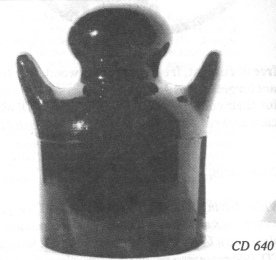
The first of these markings is embossed on the crown of an old friend, the
"Gingerbread Boy" -- CD 640 (formerly CD 781). We see the letters CL
within a diamond. I have absolutely no idea what these letters stand for, and while the insulator was probably made in France, because the style and dark
green color of the glass are typically French, it is anybody's guess whether it
was used locally or was made for export to another country. Sediver
International, the largest sales organization of its kind in the world, ships
French made glass to no fewer than 65 countries around the globe. Can any of our
readers identify the mark?
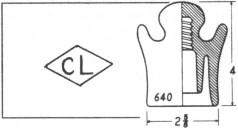
New marking and drawing of CD 640
The second marking that has recently come to our attention is stamped in green ink on the crown of a white
porcelain insulator from Italy, U-1844.
The photo of this insulator did not turn out well enough to print, so we have
used Jack Tod's drawing of it instead, along with the marking FPL within a
diamond. And, no, it's probably not Florida Power & Light! We don't know what those letters signify.
Incidentally you can see one real advantage of a drawing. It lets you look into
the interior of the insulator, something you can t always do with a picture
alone if it's glass, and of course, never, when it's porcelain.
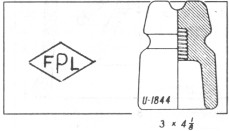
U-1844 with its unidentified marking FPL within a diamond
INTRODUCING CD 398
This is a cemented 3 piece
insulator of greenish aqua glass, embossed EIV/3 15 AT. It is a high voltage piece designed
for use on overhead transmission lines in areas where the atmosphere is polluted
and/or very damp, such as heavy industrial zones or along sea coasts. It is actually a French version of our
familiar "fog bowl," except that the outer skirt of the insulator
comes straight down like a bell as opposed to curving under and upward at the base. Isn't it a beauty?
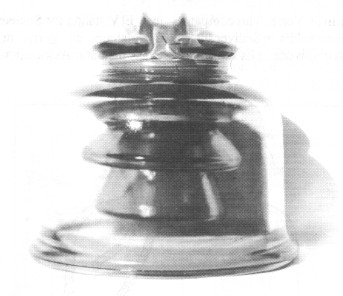
Those of you who have our book GLASS INSULATORS FROM OUTSIDE NORTH AMERICA will recognize this insulator as being very close to CD 399,
which is embossed EIV/325 AT. The drawing of it can be found on page 52 of the
1986 publication. The only difference between the two is in measurement. The CD
398 is 1" narrower and 1" shorter than CD 399.

Embossing on CD 398
As you know, EIV is a French marking indicating glass of fairly recent
manufacture (since 1958) by the SL Gobain Glassworks in St. Yorre. This company is
a major shareholder in Sediver Inter national
and is also one of its subsidiaries. EIV stands for Societe European D'Isolateurs en
Verre, or European Glass Insulator Association.
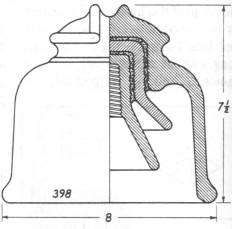
CD 398 dimensional drawing
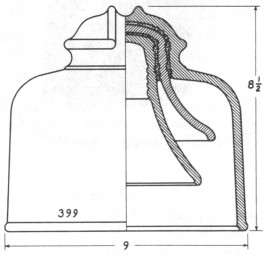
CD 399 dimensional drawing
TWO ADDITIONAL CD ASSIGNMENTS
These two glass specimens were found in Italy, in fact brought back as a gift
to an American collector quite some time ago but I don't have that name. CD 402,
as shown below, is a 2 piece terminal or "dry-spot" insulator, almost
identical in style to those made of porcelain by Bullers Ltd. and Taylor,
Tunnicliff & Co. Ltd. of England. The British often refer to this insulator pattern as a "pothead."
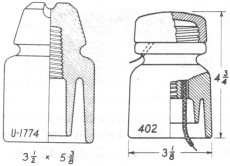
CD 402, however, is made of a pale citron yellow glass. The threaded cap
screws on as smoothly as if it had been greased. Embossed on one side of the
skirt are the letters M I V A -- certainly identifying the insulator as Italian.
This trademark has yet to be attributed to any one manufacturer, but it appears
on several styles of insulators used in Italy and since that is glass country, I
have no reason to believe the insulator was manufactured anywhere else. The real
surprise comes when the insulator is turned over and there you see the word PYREX!
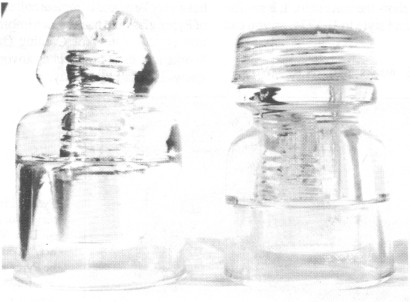
CD 539, also shown here, is just a bit light in color. Embossed on the skirt
we find TETI -- 920 -- L. On the opposite mold again we see the word PYREX. Wait just a minute! Italian Pyrex? Seems to
be alright! You can imagine how excited I was to find these two insulators. At
the moment I lack a drawing of CD 539, but the photo does clearly show the inner
skirt. It is similar in size and style to U-1774, as you can see.
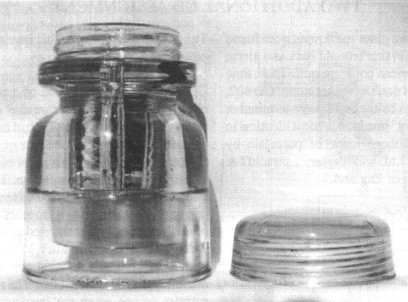
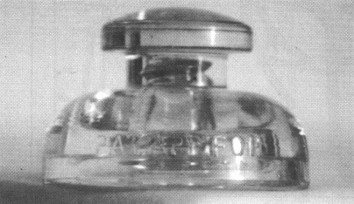
Pyrex insulator belonging to Dan Wagner.
Could it be Pyrex product for South
American use?
Several weeks ago, N.R. "Woody" Woodward sent a letter of inquiry
to the Corning Library which is part of the Corning Museum of Glass in Corning,
New York. At this writing, no reply has been received. I then wrote to Jeff
McCurty of Millville, New York. Jeff has a very large and complete collection of
Pyrex glass and has as much information on the history of Corning Glass Works
and their products as anyone I know. He had this to say:
For your information..... Corning Glass Works granted licenses to make Pyrex glass
to glass manufacturers in England and France starting in 1922. This is
interesting and even a bit bizarre in that United States production began in
1924 for the power line and radio insulators and in 1926 for the communication
insulators. I have no record of any licenses being granted to Italian glass
makers, but maybe these were made in England? (Jeff, I doubt that for the reason
I gave above -- that Italy wouldn't need to look elsewhere for glass production
-- Marilyn) Corning Glass Works does have numerous factories around the world.
I've heard there is one in South America -- maybe Brazil. It is very possible
there are mare Pyrex insulators around. Could Dan's (Wagner) little insulator
fit into any foreign electrical usage?
Jeff is referring to the mystery Pyrex
insulator written up in the November 1987 issue of CROWN JEWELS. A picture of the
insulator is on the previous page. Jeff, as I remember, that insulator had a
5/8" pinhole with American threads, didn't it? If Dan Wagner's insulator
was used in another country, that would most likely be in South America. Not
only did some of those countries copy U.S. insulator styles, but they used the
American thread as well. If it were not for the embossing, it would have been
difficult to tell them apart. Interesting food for thought, though!
Thanks, Jeff, for your help. We may try one more time to contact the Corning
Library, now that we have actual photographs of Pyrex insulators that were
very likely made in Italy. We'll let you know if we receive an answer.
| 